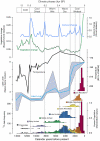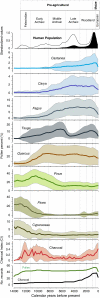Synchronous environmental and cultural change in the prehistory of the northeastern United States
- PMID: 21135208
- PMCID: PMC3009810
- DOI: 10.1073/pnas.1005764107
Synchronous environmental and cultural change in the prehistory of the northeastern United States
Abstract
Climatic changes during the late Quaternary have resulted in substantial, often abrupt, rearrangements of terrestrial ecosystems, but the relationship between these environmental changes and prehistoric human culture and population size remains unclear. Using a database of archaeological radiocarbon dates alongside a network of paleoecological records (sedimentary pollen and charcoal) and paleoclimatic reconstructions, we show that periods of cultural and demographic change in the northeastern United States occurred at the same times as the major environmental-climatic transitions of that region. At 11.6, 8.2, 5.4, and 3.0 kyr BP (10(3) calendar years before present), changes in forest composition altered the distribution, availability, and predictability of food resources which triggered technological adjustments manifested in the archaeological record. Human population level has varied in response to these external changes in ecosystems, but the adoption of maize agriculture during the late Holocene also resulted in a substantial population increase. This study demonstrates the long-term interconnectedness of prehistoric human cultures and the ecosystems they inhabited, and provides a consolidated environmental-cultural framework from which more interdisciplinary research and discussion can develop. Moreover, it emphasizes the complex nature of human responses to environmental change in a temperate region.
Conflict of interest statement
The authors declare no conflict of interest.
Figures



References
-
- Webb T, III, et al. In: Global climates since the Last Glacial Maximum. Wright HE, et al., editors. Minneapolis: University Minnesota Press; 1993. pp. 415–467.
-
- Williams JW, Shuman B, Webb T, III, Bartlein PJ, Ledux PL. Late-Quaternary vegetation dynamics in North America: scaling from taxa to biomes. Ecol Monogr. 2004;74:309–334.
-
- Coombes P, Barber K. Environmental determinism in Holocene research: causality or coincidence? Area. 2005;37:303–311.
-
- O’Sullivan P. The “collapse” of civilizations: what palaeoenvironmental reconstruction cannot tell us, but anthropology can. Holocene. 2008;18:45–55.
-
- deMenocal PB. Cultural responses to climate change during the late Holocene. Science. 2001;292:667–673. - PubMed
Publication types
MeSH terms
LinkOut - more resources
Full Text Sources
Medical
Molecular Biology Databases

